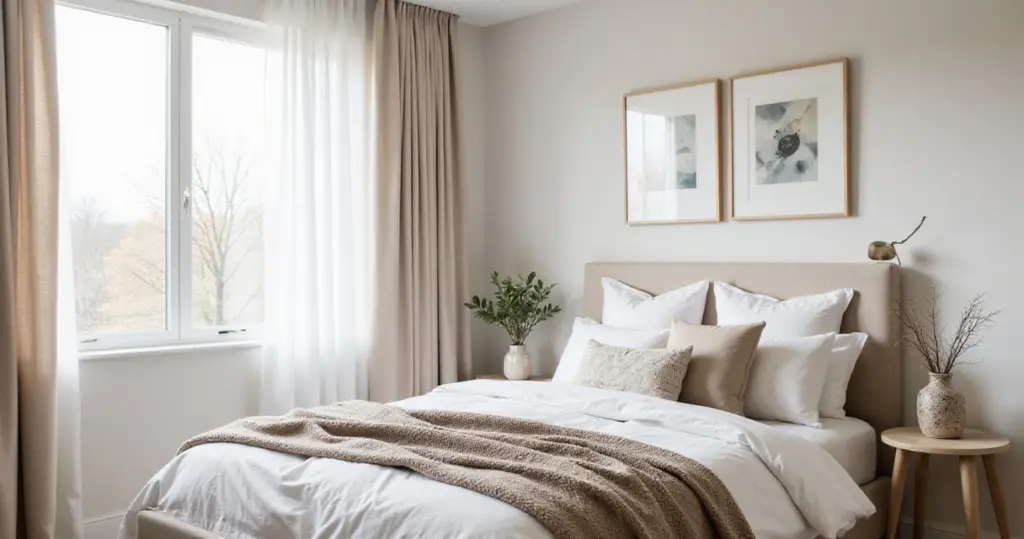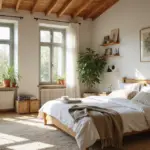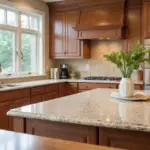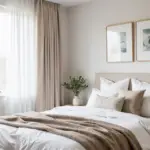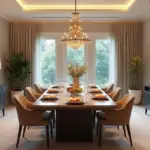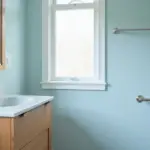You know what clients always ask me? It’s not about the sofa or the perfect shade of white. They pull me aside, often in their half-finished bedroom, and whisper, “Ava, what do I actually do with these walls?” They’re paralysed by the endless options, the fear of getting it wrong, of creating a space that feels generic or, worse, just a jumble of things they liked on the internet.
And I get it. Your bedroom walls are the last thing you see at night and the first thing you see in the morning. They’re the backdrop to your life. Getting them right isn’t about just filling space; it’s about crafting a feeling, a sanctuary that’s uniquely yours. It’s about telling your story, whether that’s with a single, magnificent piece of art or a collection of small, cherished memories. So let’s talk about it, friend to friend. Here’s how we move beyond blank walls and create something truly beautiful.
Strategic Planning & Aesthetic Foundations
Right, before you even think about picking up a hammer or a paintbrush, we need a plan. So many people skip this bit, get excited, buy a dozen things that look lovely on their own, and then wonder why their room feels chaotic. A little bit of thought upfront saves a world of heartache (and returns) later.
1. Define Your Bedroom Style & Cohesive Theme
This is the absolute bedrock of it all. You wouldn’t start cooking without a recipe, so why would you start decorating without a vision? Having a clear theme isn’t about being rigid; it’s about giving yourself a filter. It’s the voice in your head that says, “Yes, that antique brass mirror is perfect,” or “No, that neon sign, as fun as it is, doesn’t belong here.” It’s what separates a room that feels thoughtfully collected from one that looks like a jumble sale.
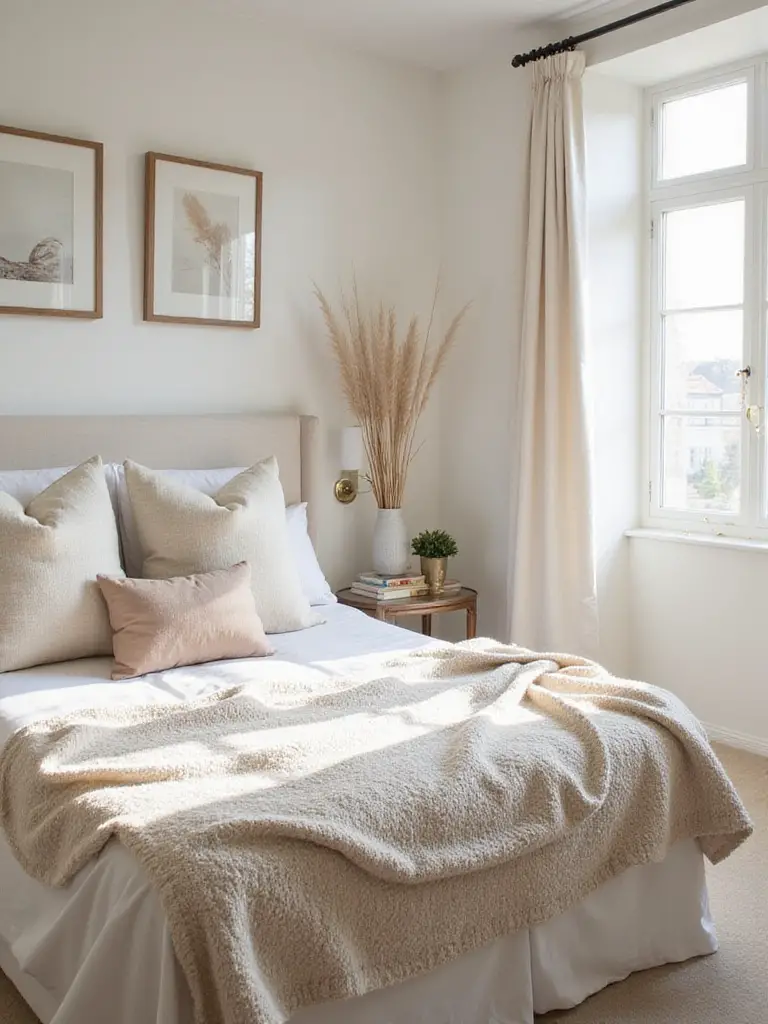
For me, this is where the magic really happens. It’s about the blend. I had a client who loved the clean, almost stark lines of modern British design but wanted to honour her Indian heritage. We settled on a theme of “Luxe Sanctuary.” This gave us our guide. We chose a deep, moody teal for the walls, paired it with a sleek, minimalist bed from Heal’s, and then brought in the heritage with two stunning bedside tables intricately inlaid with bone from Jodhpur. The theme held it all together.
Now that we know the feeling we’re chasing, let’s look at the space we have to work with.
2. Assess Wall Space Dimensions for Optimal Impact
Can we talk about my biggest pet peeve? It’s postage stamp art. You know what I mean—a tiny, lonely little frame floating in a vast sea of wall. It just looks timid and lost. Measuring your space isn’t just about knowing if a piece will physically fit; it’s about making sure it has presence and commands the right amount of attention. It’s the difference between an intentional design choice and a sad afterthought.
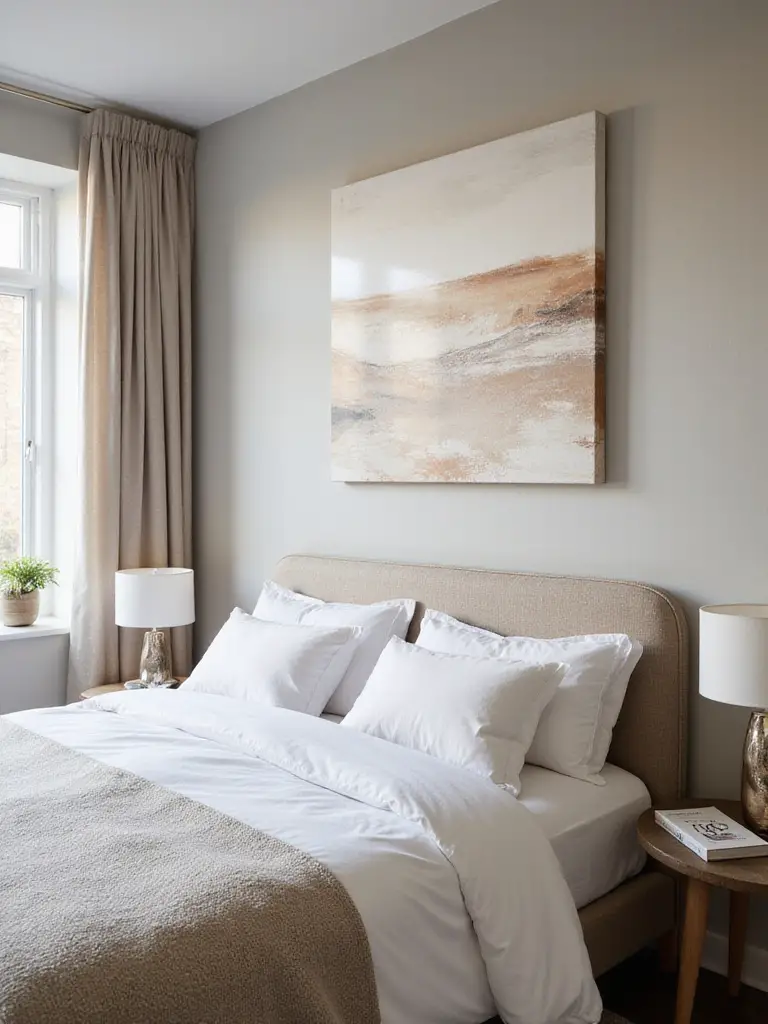
Here’s my shortcut, and you don’t need any fancy apps. Get some painter’s tape. Before you buy a single thing, use the tape to map out the size of the artwork or gallery wall you’re considering. Live with it for a day or two. Does it feel balanced over the bed? Does it feel crowded? This little trick has saved my clients so much money and so many nail holes. It lets you feel the scale before you commit.
3. Curate a Relaxing Color Palette for Serene Walls
Colour is emotion. It’s as simple as that. In a bedroom, we’re aiming for colours that soothe the soul, not jolt you awake. And this doesn’t have to mean boring beige. Some of the most serene bedrooms I’ve designed have been drenched in deep, enveloping colour. The key is choosing colours with the right undertone—think muted, earthy, or ‘dusty’ versions of your favourite shades.
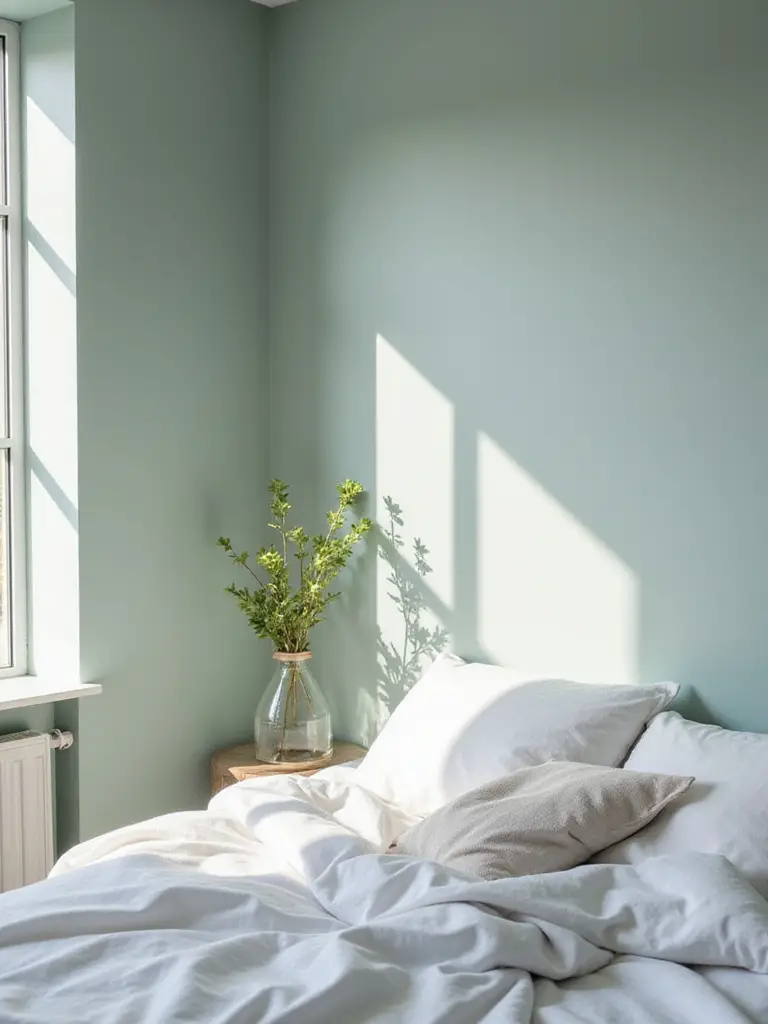
I often pull my palettes from nature and textiles. Instead of a standard yellow, I might suggest a warm, gentle turmeric. Instead of a flat grey, perhaps a soft ‘monsoon’ grey with hints of blue and green. A client of mine fell in love with a vibrant vintage silk sari. We didn’t hang the sari, but we pulled the most subtle, dusky rose from its border and painted the entire room in that colour. The result was a space that felt warm, unique, and deeply personal, all inspired by a single thread of colour.
4. Establish a Realistic Budget for Smart Decor Choices
Let’s be honest, we don’t all have an unlimited budget. But that doesn’t mean you can’t have a beautiful room. Budgeting isn’t about restriction; it’s about strategy. It’s about deciding where to splurge and where to save. You can create a high-end look by being clever about where your money goes. A mix of high and low is the secret to almost every gorgeous room you’ve ever admired.
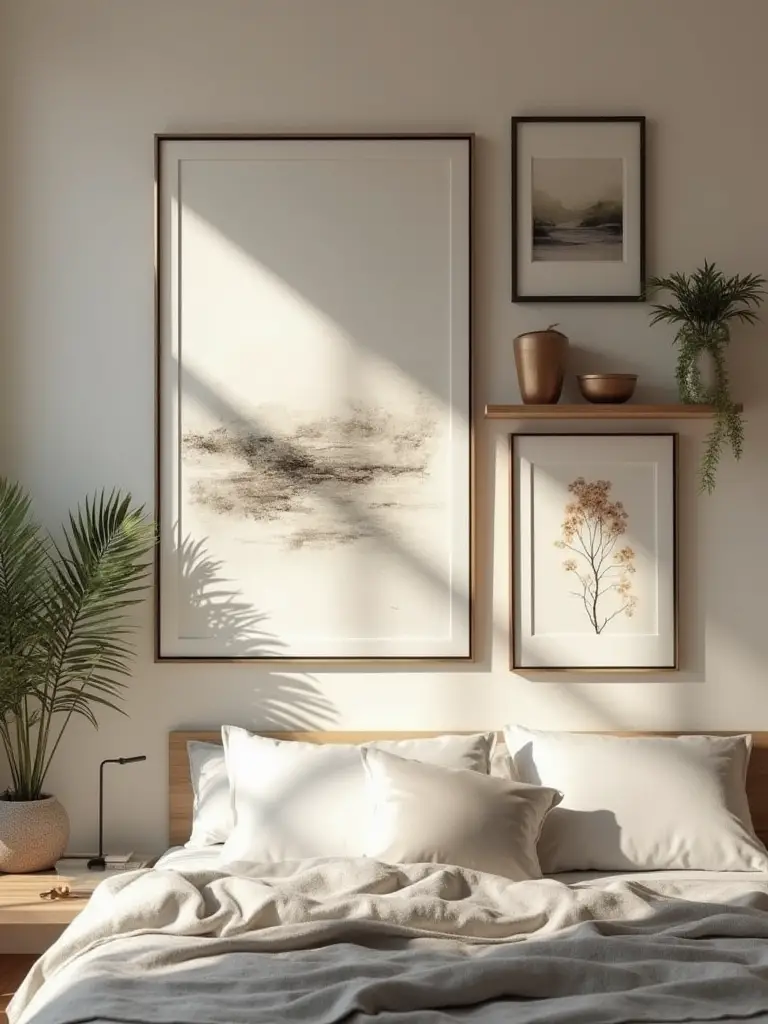
My advice is always to splurge on the one thing that will have the most impact and make your heart sing. For one project, it was an exquisite, hand-knotted rug. For another, it was a massive, vintage Pichwai painting we found in an antique shop in Jaipur. We made that the star of the show and then saved everywhere else—we used simple frames from IKEA for a gallery wall and found lovely linen bedding from a high-street shop. No one notices the frames; they only see the breathtaking painting that anchors the whole room.
Now that our foundations are set, let’s get to the fun part: arranging everything.
Mastering Layout & Arrangement Techniques
This is where the artistry comes in. You’ve got your pieces, you know your colours, now how do you put them all together on the wall so they look effortless and elegant, not stiff or cluttered? It’s all about balance, breathing room, and a little bit of creative rule-breaking.
5. Design Engaging Gallery Walls with Ease
The biggest lie people are told about gallery walls is that everything needs to match. All the frames the same colour, all lined up in a perfect grid. To me, that’s not a story; it’s a spreadsheet. A truly brilliant gallery wall is a collection that feels gathered over time. It’s a mix of art, photography, and personal objects that tell the world who you are. The key is finding one thing to unify it all—a common colour thread, a similar theme, or even just a shared feeling.
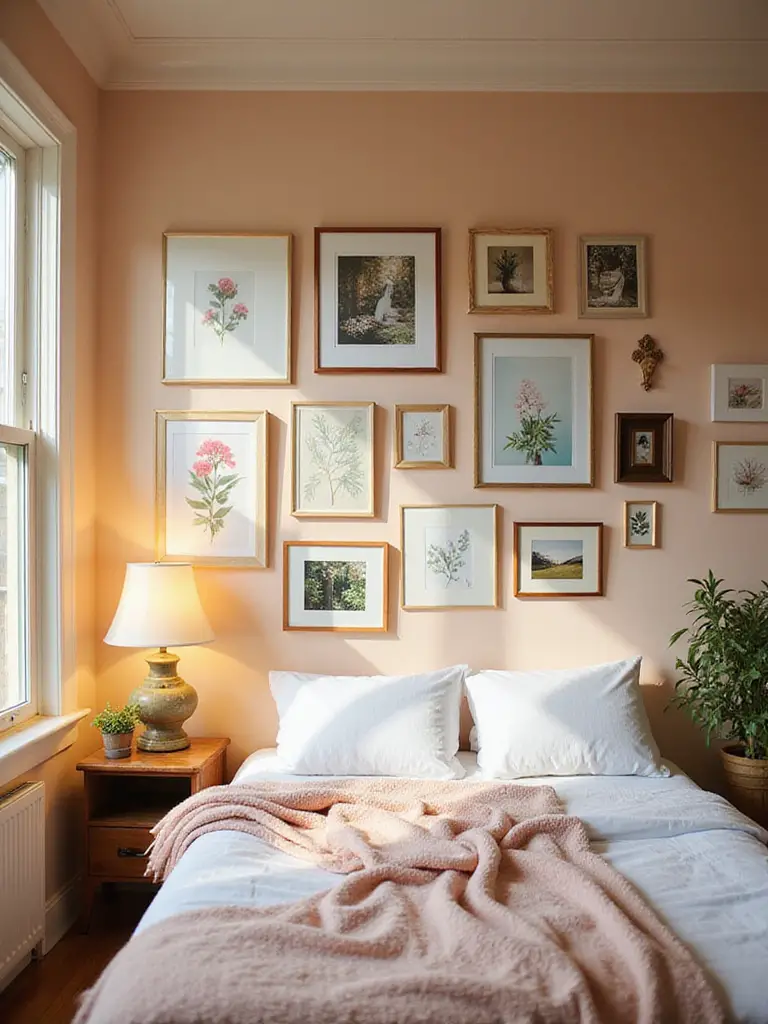
I once helped a couple create a gallery wall that blended their two lives—he was British, she was from Pakistan. We mixed his moody black-and-white photographs of the Scottish Highlands with her collection of small, colourful Phulkari embroidered textiles. We framed everything differently—some in ornate silver frames, others in simple black. The thing that held it all together? Every single piece spoke of landscape and heritage. It was personal, beautiful, and completely unique.
6. Utilize Asymmetrical Balance for Dynamic Walls
Symmetry can be lovely, but it can also be a bit… predictable. Asymmetry is its cooler, more sophisticated older sister. It’s the art of creating balance without making everything a perfect mirror image. Think of it like this: a large painting on one side of the bed can be balanced by a smaller cluster of three little frames on the other. It feels more organic, more dynamic, and far more interesting to the eye.
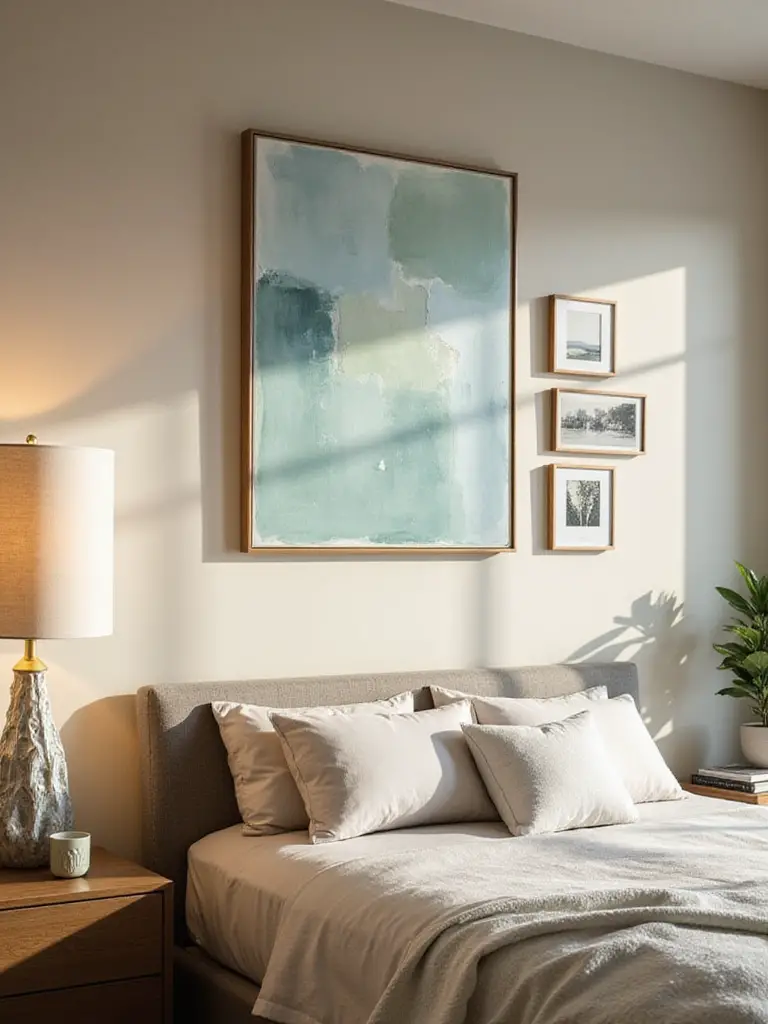
This is a brilliant technique for blending styles because it doesn’t demand that everything “matches.” You can have a very modern, abstract print balanced by a piece of ancient, weathered teak from an old haveli. They don’t look alike, but their visual “weight” feels correct together. It’s a quiet confidence. It says, “These things don’t match, but they belong together.”
7. Incorporate Negative Space to Create Visual Calm
In design, the empty space is just as important as the space you fill. Sometimes, the most luxurious thing you can give a beautiful object is room to breathe. Don’t feel the need to cover every square inch of your walls. Leaving some ‘negative space’ gives the eye a place to rest and makes the pieces you do choose to display feel so much more important and deliberate.
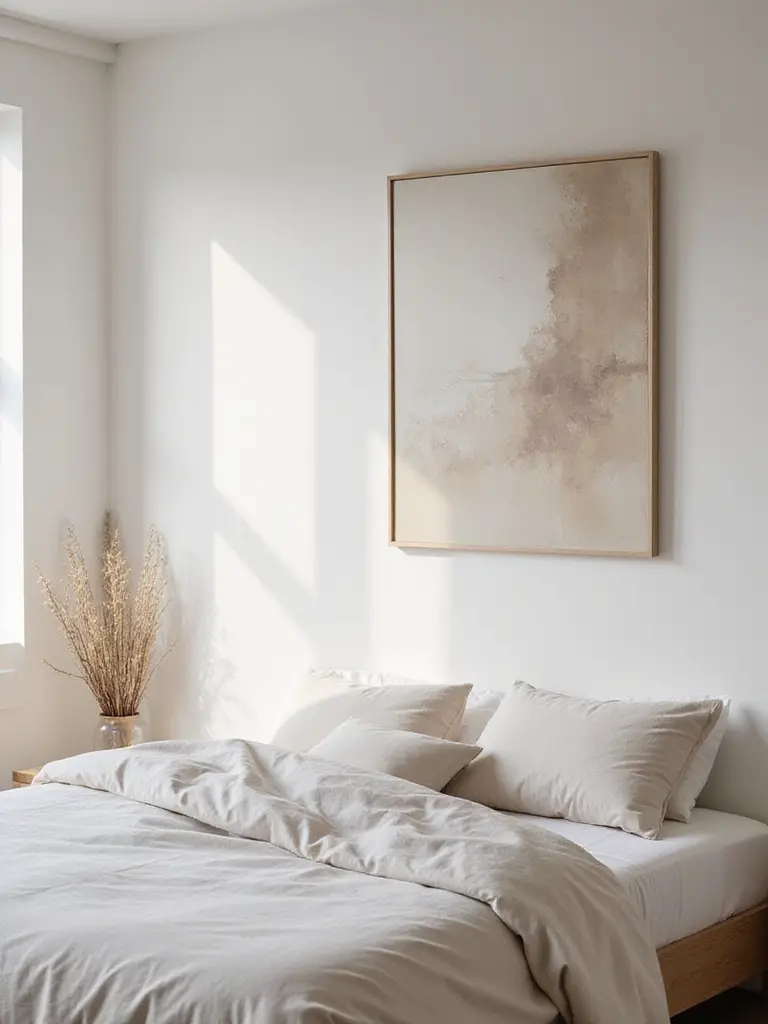
This is especially true when you’re working with ornate or intricate pieces, which are so common in South Asian design. If you have a stunning, hand-carved jali screen or a rich, detailed Kalamkari tapestry, let it be the star. Don’t crowd it with a dozen other little things. Place it on a clean wall and let its craftsmanship shine. The emptiness around it becomes part of the art.
8. Choose a Statement Piece to Define Your Focal Point
Every room needs a hero. A single, show-stopping piece that immediately draws your eye and sets the tone. In the bedroom, this is usually on the wall above your bed. Choosing a powerful statement piece is the quickest way to give your room a sense of purpose and a massive dose of personality. It stops the eye from wandering around aimlessly and gives the whole space an anchor.
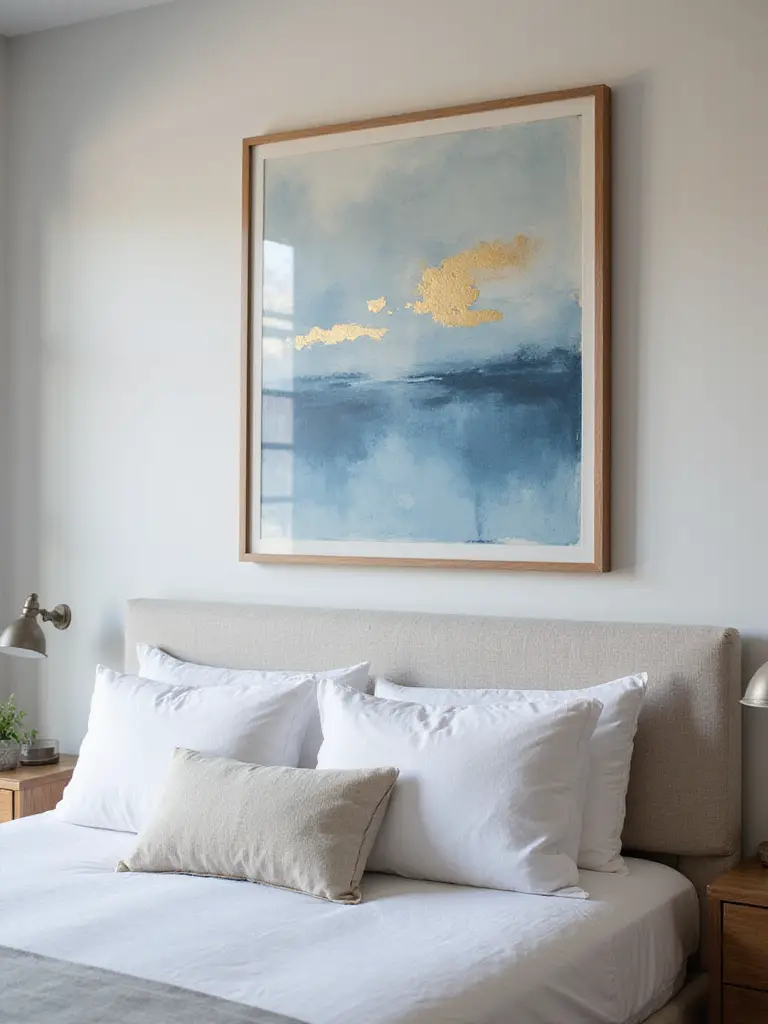
Forget a standard headboard. Go for something with soul. I’ve used massive, antique doors from Gujarat as a headboard. I’ve hung a gigantic, contemporary canvas by a young British-Indian artist. My favourite was for a client in London; we sourced a huge, circular piece of hammered brass metalwork from a souk in Morocco and mounted that above their bed. It was unexpected, dramatic, and completely transformed the room from nice to unforgettable.
9. Apply Proper Scale and Proportion for Harmonious Walls
We touched on this with the ‘postage stamp art’ problem, but it’s worth repeating because it’s the number one mistake people make. Getting the scale right means your decor feels connected to the furniture and the room itself, not just floating randomly in space. It’s about creating a conversation between the objects in your room.
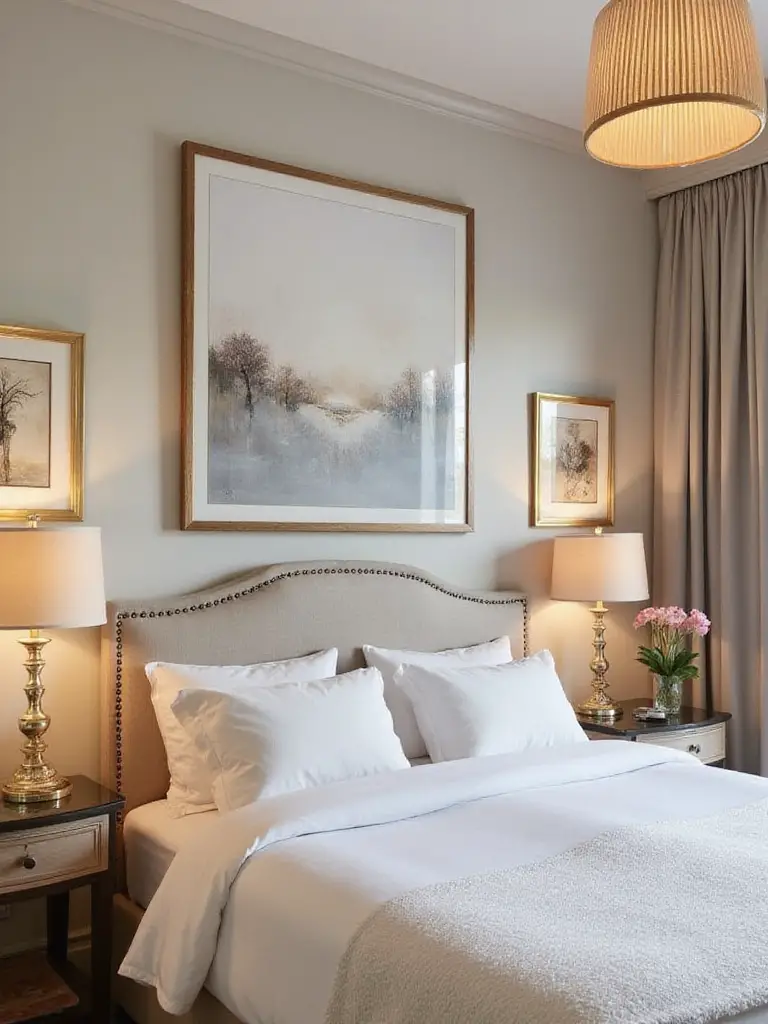
Here’s the rule of thumb I give everyone: any art or gallery wall above a piece of furniture (like your bed or a dresser) should be about two-thirds the width of that furniture. And please, hang it at the right height! The centre of the artwork should be at eye level (about 57 inches from the floor), or if it’s over furniture, hang it just 6-8 inches above. This one small adjustment makes everything feel grounded and intentional.
Now let’s move beyond frames and paint and talk about the wonderful world of texture.
Diverse Materials & Textured Decor Options
A room that only has flat surfaces can feel a bit lifeless. Bringing in different materials and textures is what gives a space depth, warmth, and character. It’s what makes you want to reach out and touch the walls.
10. Integrate Textile Art for Warmth and Acoustic Benefits
Textiles are my secret weapon. They add instant softness, colour, and pattern, and they have the brilliant side effect of absorbing sound, making your bedroom feel quieter and more cocoon-like. Forget generic canvas art; a beautiful textile has a soul and a history you can feel. It’s the easiest way to bring a global, collected feel into a contemporary space.
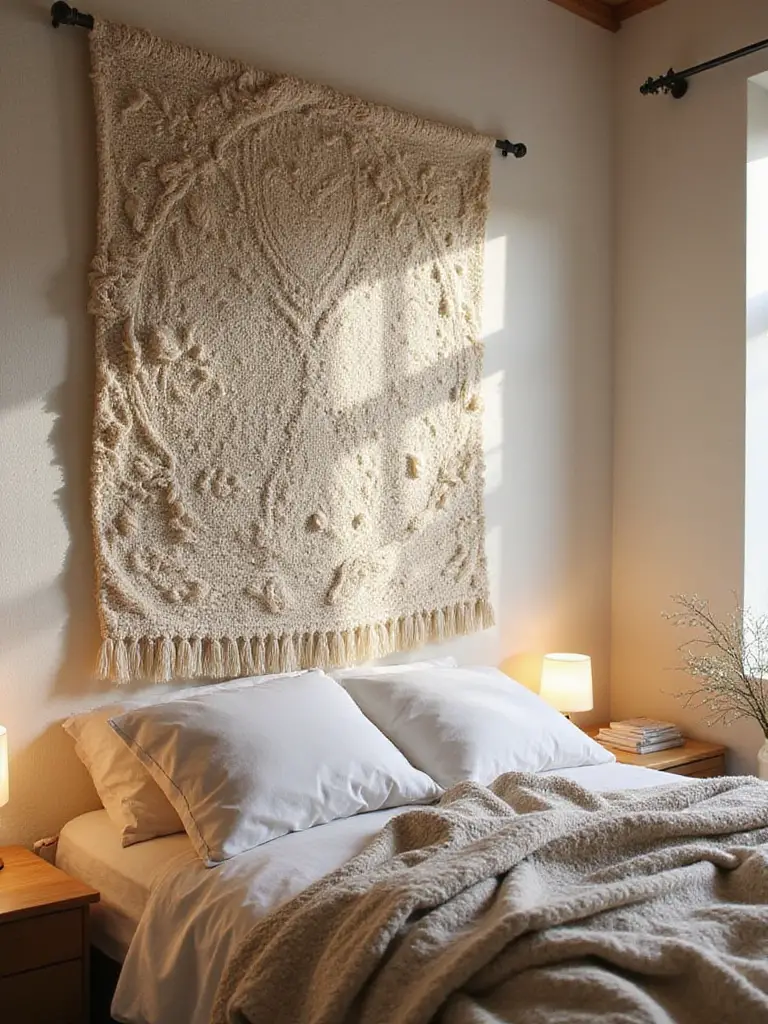
And you have so many options! Think beyond a simple wall hanging. Frame a stunning piece of a vintage silk sari. Hang a beautiful Kantha quilt from West Bengal, with its thousands of tiny, hand-sewn stitches. I once used a gorgeous, heavily embroidered Suzani from Uzbekistan as a headboard. It brought incredible texture and a rich story into an otherwise very simple, modern room.
11. Add Strategic Mirrors to Expand Perceived Space
Mirrors are pure magic, especially in smaller British homes. They’re the oldest trick in the book for a reason: they bounce light around, make a room feel bigger, and can double a beautiful view. But don’t just stick any old mirror on the wall. Think of it as a piece of art that just happens to be reflective.
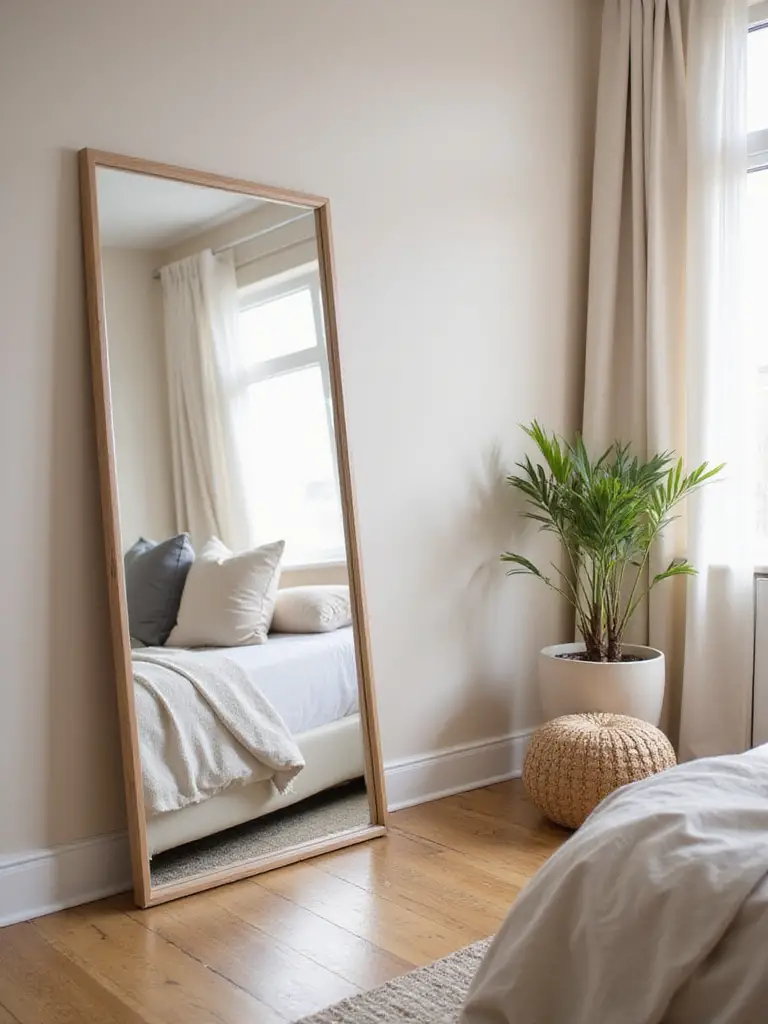
Choose a mirror with a beautiful frame that adds to your story. I love using mirrors with intricate bone-inlay frames from Rajasthan for a touch of Indian romance, or ones with chunky, carved wooden frames for a more rustic, colonial feel. Pro tip: place a mirror opposite a window. It will capture all that natural light and throw it back into the room, making everything feel brighter and more alive.
12. Mount Floating Shelves for Functional Display Versatility
Floating shelves are a brilliant way to get some functional display space without the bulk of a bookcase or a cabinet. They offer a place to create little vignettes—a curated collection of objects that tell a small story. They’re perfect for that blend of modern and traditional we love.
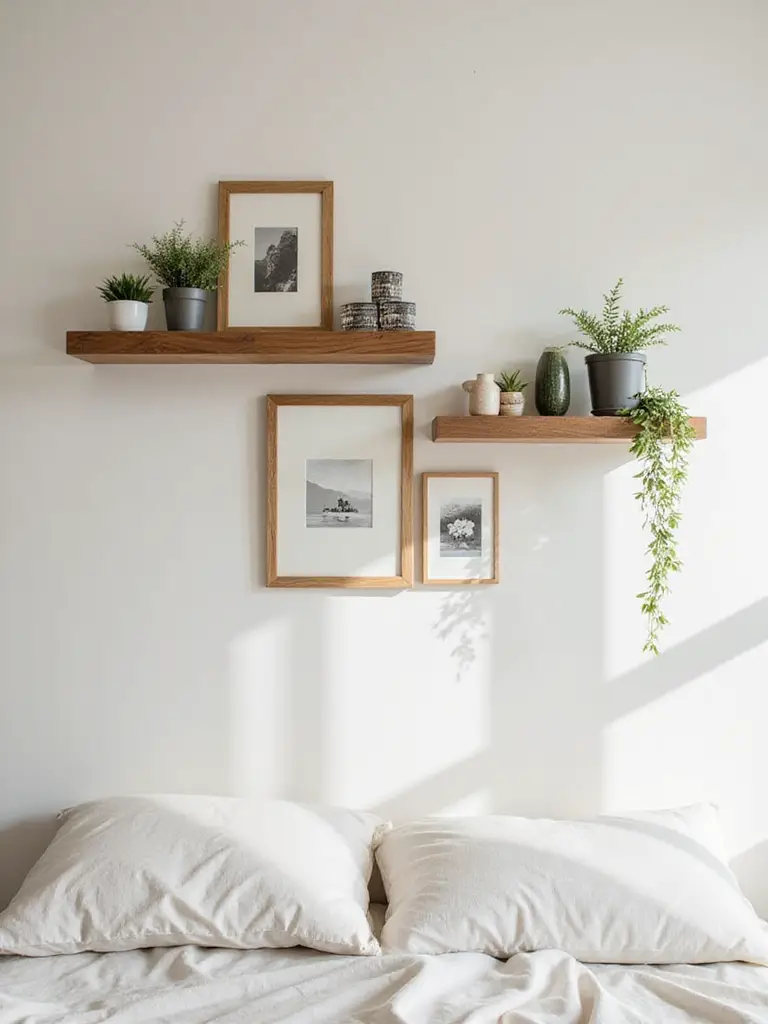
Don’t just line things up. Style them. Mix heights, textures, and eras. On a single shelf, I might place a very sleek, modern ceramic vase, a stack of old books, and a small, antique brass diya (oil lamp). Each object is lovely on its own, but together, they create a composition that is personal and interesting. It’s a tiny, contained gallery on your wall.
13. Apply Peel-and-Stick Wallpaper for Effortless Style Updates
For anyone who is a bit of a commitment-phobe with design (or is renting!), peel-and-stick wallpaper is a complete game-changer. It gives you the high-impact look of traditional wallpaper without the mess, the expense, or the permanence. It’s the perfect way to experiment with a bold pattern or texture on an accent wall.
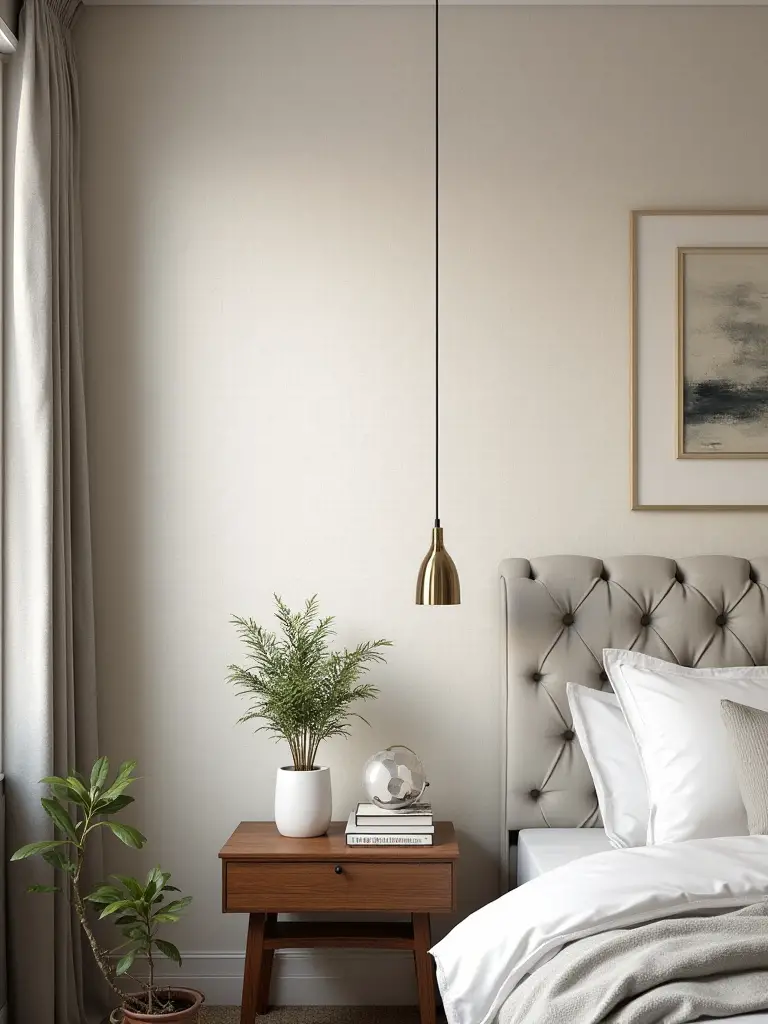
The quality has become incredible in recent years. I’ve found some brilliant designs that mimic traditional Indian block prints, like a beautiful Sanganeri floral, but in a very contemporary, muted colour palette. You can get the look of a bespoke, hand-blocked wall for a fraction of the price and effort. It’s perfect for adding a dose of pattern and personality behind a bed.
Now let’s talk about making things truly, deeply you.
Creative & Personal Touches
This is the part that no one else can replicate. It’s about taking all these design principles and infusing them with your own life, your memories, and your passions. This is what transforms a well-designed room into your room.
14. Showcase Personal Photography for Cherished Memories
There is nothing more personal than surrounding yourself with the faces and places you love. Forget stock art of a beach you’ve never been to. A wall of personal photos tells the story of your life. The key to making it look like a curated collection and not a chaotic scrapbook is to be intentional with your framing and editing.
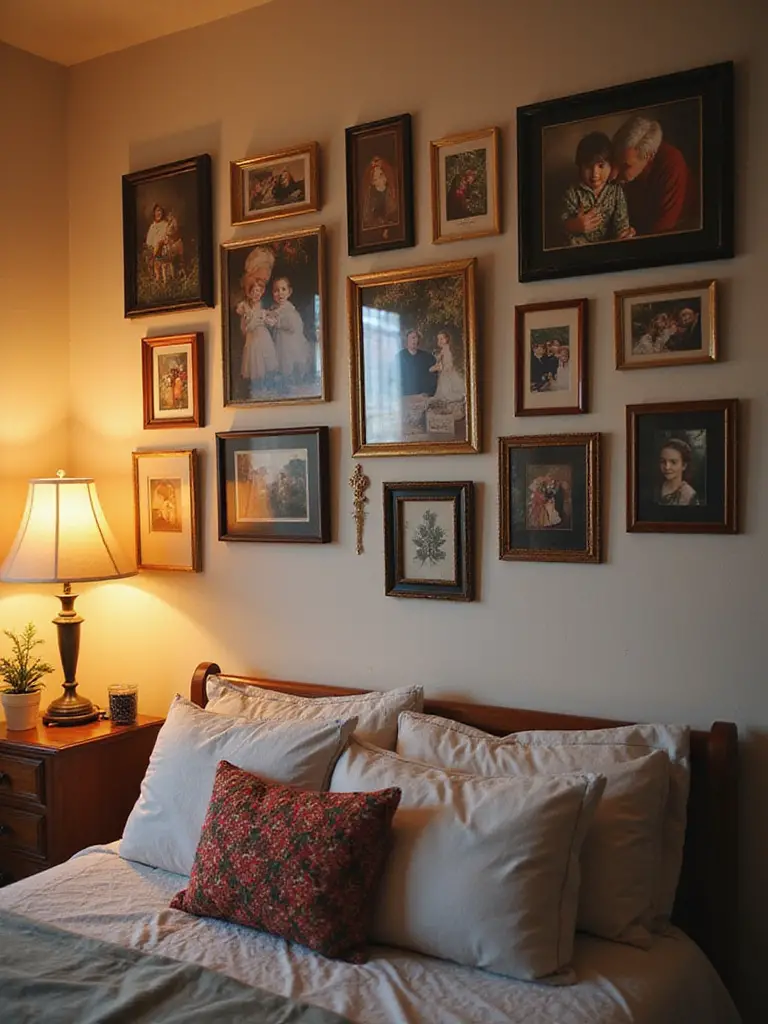
For a really chic, cohesive look, try printing all your photos in black and white. It instantly elevates them and makes disparate images feel like they belong together. Then, play with the frames. Don’t feel like they all have to match. I love mixing sleek, modern frames with a few ornate, vintage silver ones I’ve picked up from antique markets in India. It adds a layer of history and character.
15. Source Unique Vintage Finds for Timeless Character
This is my favourite part of any project—the hunt! Adding vintage pieces to your walls gives your room an instant sense of soul and history. It’s the antidote to a flat-pack, catalogue world. These are pieces with a past, with imperfections that make them perfect. They prove your home wasn’t decorated overnight.
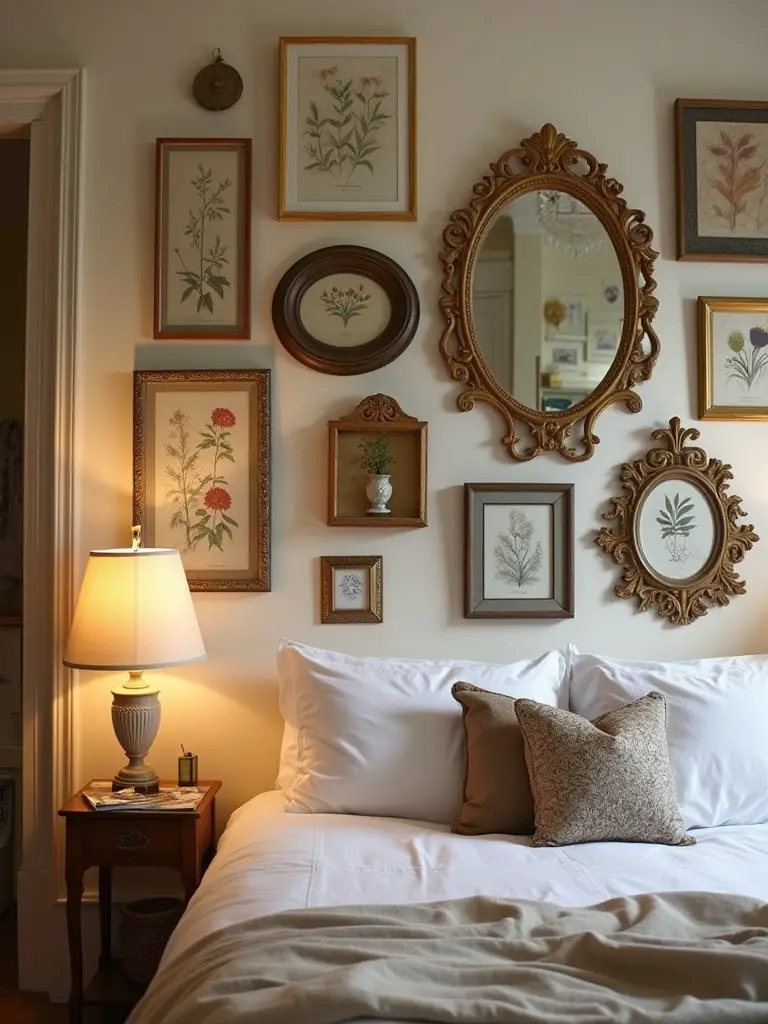
Look beyond art. An old, beautifully patinated brass tray from a Turkish bazaar can be hung on the wall. A collection of antique wooden printing blocks from a textile workshop in Rajasthan can be mounted in a shadow box. I once found a gorgeous, albeit slightly damaged, piece of a hand-painted screen. We framed the intact section, and it became the most talked-about piece in the room. Don’t be afraid of things with a bit of wear and tear—that’s their story.
16. Create DIY Wall Art Projects for Budget-Friendly Style
You don’t have to be an artist to create your own beautiful art. Some of the most stunning wall decor I’ve seen has been handmade, and it’s often the most meaningful. It’s also incredibly budget-friendly, which is always a bonus. It’s about seeing the potential in everyday materials.
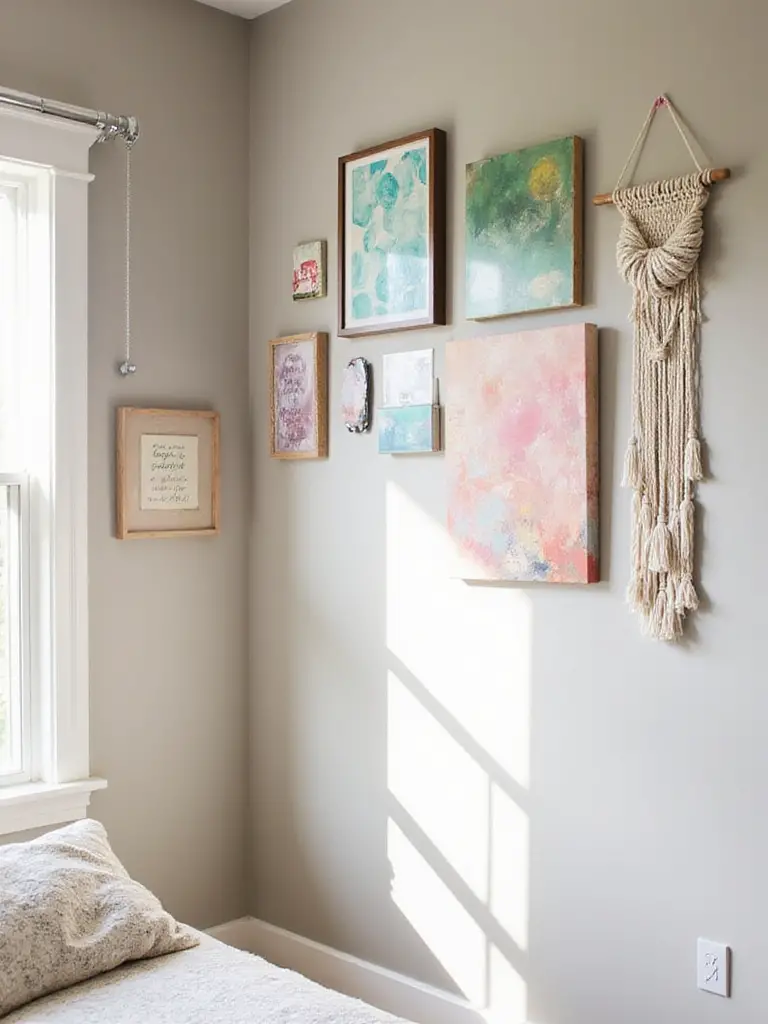
One of the easiest and most effective DIYs I recommend is framing fabric. If you have a beautiful scarf you never wear, a scrap of a beloved old garment, or even a stunning tea towel, frame it! I have a client who framed a piece of her mother’s wedding sari—a gorgeous red Banarasi silk with gold threadwork. It’s simple, personal, and looks a million dollars.
17. Integrate Indoor Plants with Wall Planters for Greenery
Bringing life into your bedroom—literally—is a wonderful way to soften a space and add a touch of nature’s beauty. Wall planters are fantastic because they draw the eye upwards and add greenery without taking up precious space on your bedside table or floor. They make a wall feel alive and breathing.
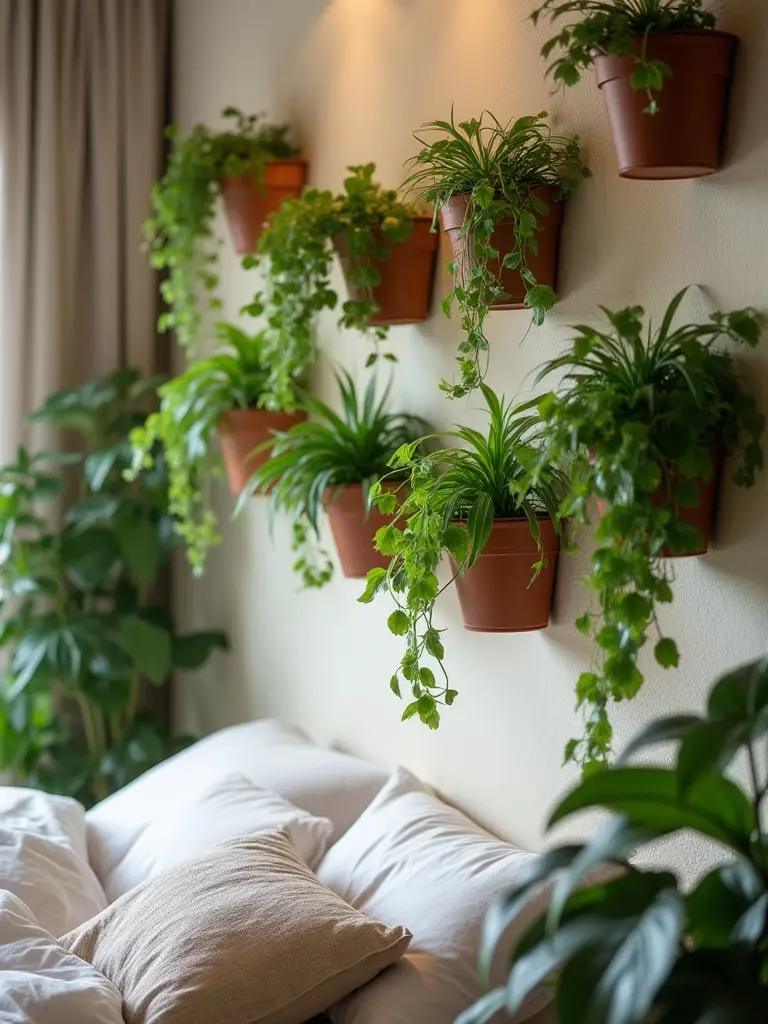
Instead of standard plastic pots, look for planters that add to your aesthetic. Find beautiful, hand-thrown terracotta pots for an earthy, rustic feel, or source colourful, patterned ceramic ones that echo the block-print motifs of your textiles. A collection of trailing plants like Pothos or Philodendron cascading down a wall is one of the most serene and beautiful sights to wake up to.
Now, let’s finish with some smart tips to make it all work seamlessly.
Functional Integration & Smart Execution
Great design isn’t just about looking good; it’s about working beautifully, too. These final touches are about making your walls smarter, more functional, and adaptable for the future.
18. Install Integrated Lighting for Enhanced Mood Ambiance
Lighting is everything. You can have the most beautiful room in the world, but if it’s lit by a single, harsh overhead bulb, it will never feel inviting. Integrated lighting—like LED strips hidden behind a headboard or subtle washes of light grazing a textured wall—is the secret to creating a high-end, hotel-like mood.
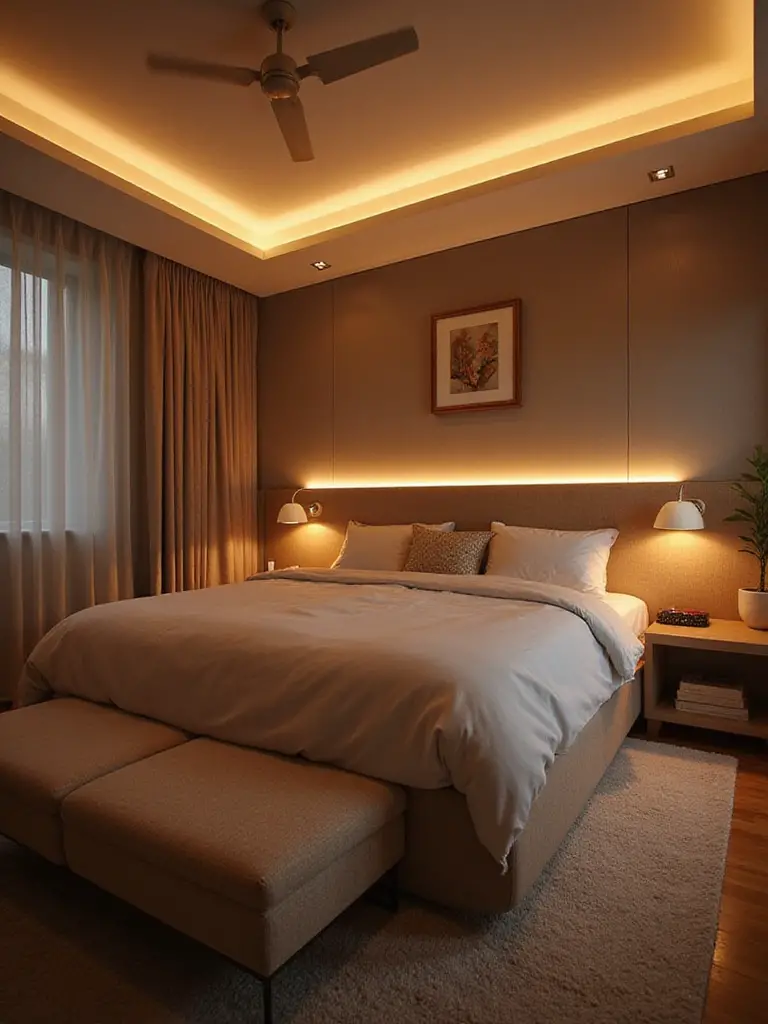
My favourite trick is to use it to highlight texture. If you have a wall with a beautiful lime-wash finish, a textured wallpaper, or a stunning textile hanging, washing it with a soft light from above or below will bring all that gorgeous detail to life in the evening. It adds depth and drama and makes the room feel incredibly luxurious and calming.
19. Optimize Wall-Mounted Storage Solutions for Decluttering
A calm bedroom is a clutter-free bedroom. Getting things off the floor and surfaces and onto the walls is key to creating that serene, minimalist feel that is so central to modern British design. But storage can be beautiful in its own right; it doesn’t have to be purely utilitarian.
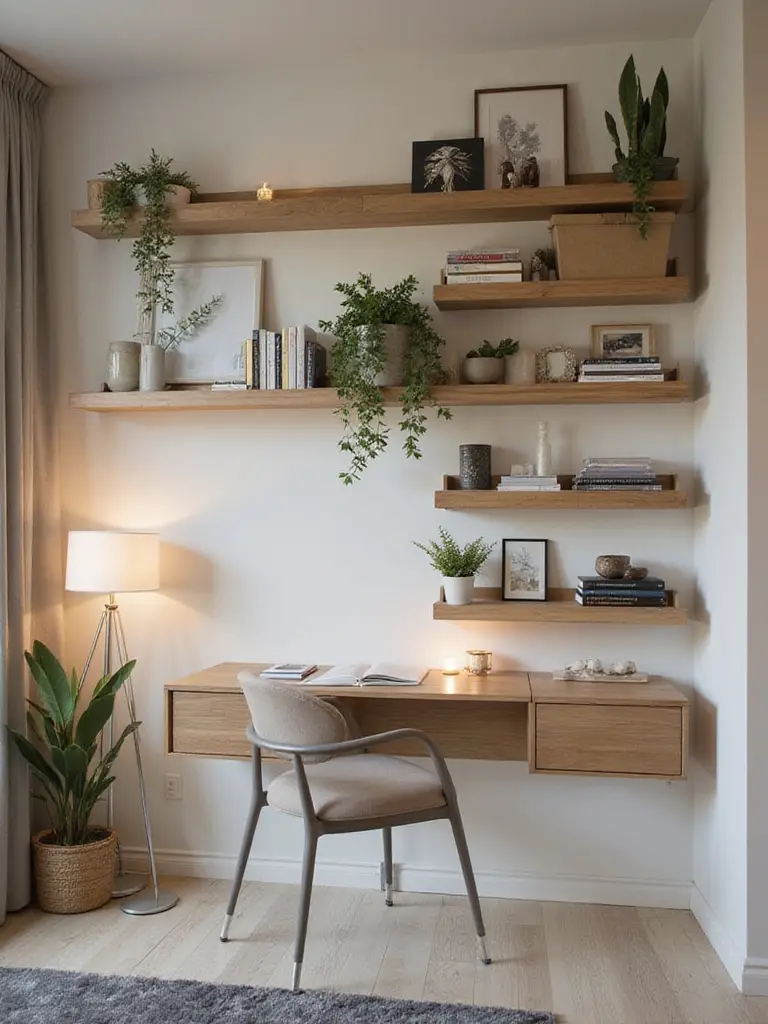
Think about a modular system that combines open shelves with closed cabinets. On the open shelves, display your beautiful, curated objects—your heritage pieces, your favourite books. In the closed cabinets, hide away the less sightly necessities. This mix of revealing and concealing is the key to storage that feels like an integrated and intentional part of your wall decor.
20. Utilize Damage-Free Hanging Methods for Rental Walls
For anyone who rents, this is your gospel. The fear of losing your security deposit has held too many people back from making their space feel like home. Thankfully, damage-free hanging solutions are so good now that there’s no excuse for bare walls. Adhesive strips and hooks have become incredibly strong and reliable.
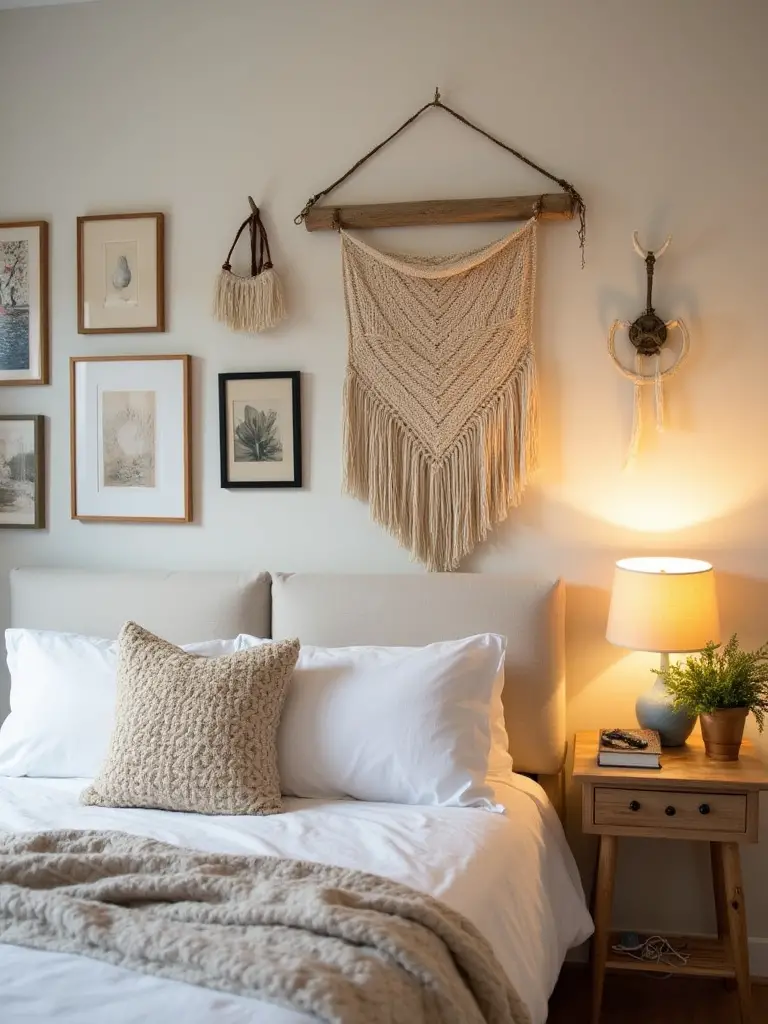
My advice is to always buy the strips that hold more weight than you think you need—it gives you a bit of a safety margin. And please, read the instructions! The secret to making them work is cleaning the wall with rubbing alcohol first. It seems like a fussy extra step, but it’s what makes the adhesive bond properly. It’s a tiny bit of effort for total peace of mind.
21. Plan for Easy Decor Swaps to Refresh Your Look
Your home should evolve with you. The person you are today might not have the exact same taste five years from now. Designing for adaptability is one of the smartest things you can do. It allows you to refresh your space without a massive overhaul. The hero of adaptable design? The picture ledge.
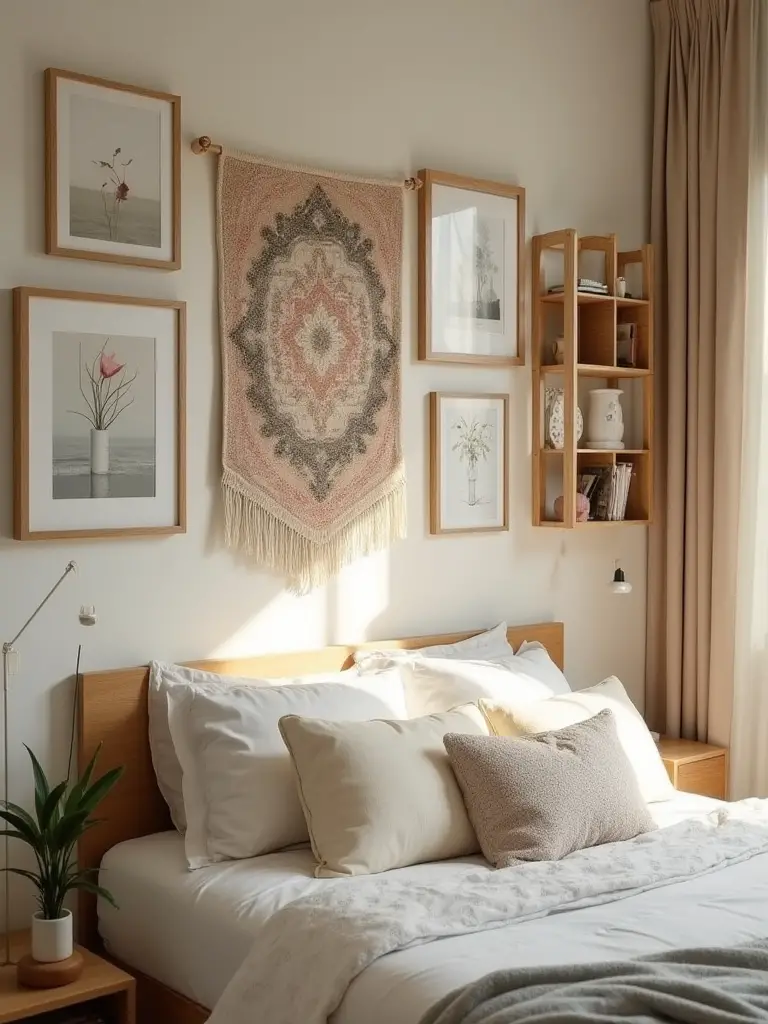
Install a few long, floating picture ledges on your wall. This allows you to overlap frames, lean art, and swap things out on a whim. You can change your entire gallery wall in ten minutes with zero new holes. I encourage clients to build a little “art library” of different prints and photos they can rotate. You can change the feel of your room with the seasons, or just whenever you feel like you need a fresh perspective.
Conclusion
So there you have it. Your walls are not just structural necessities; they are a canvas for your life. They hold the potential to be a source of calm, a reflection of your heritage, and a gallery of your most cherished memories. By blending thoughtful planning with personal, creative touches, you can craft a bedroom that is more than just a place to sleep—it becomes a true sanctuary, a space that nurtures your soul.
Don’t be afraid to mix the old with the new, the sleek with the ornate, the high-street with the heirloom. Your unique story is your greatest design asset. So, pick one idea from this list that excites you and just begin. Your dream retreat is waiting.
